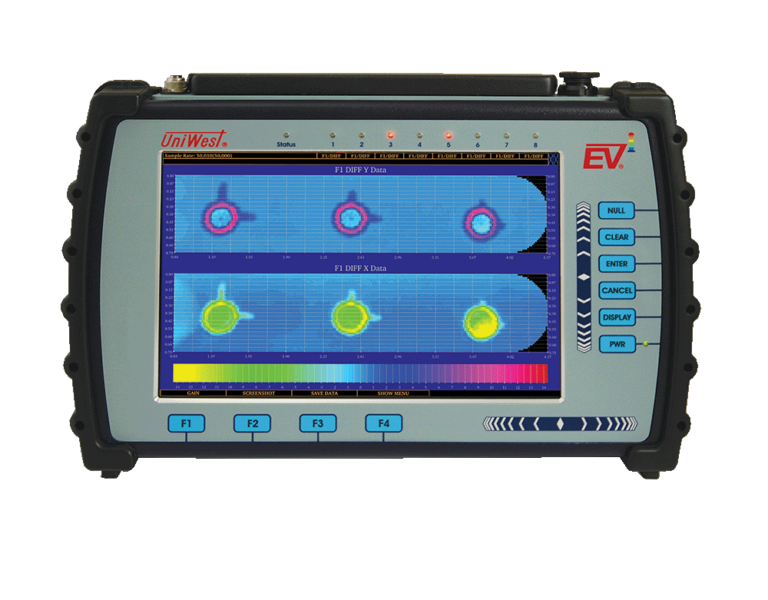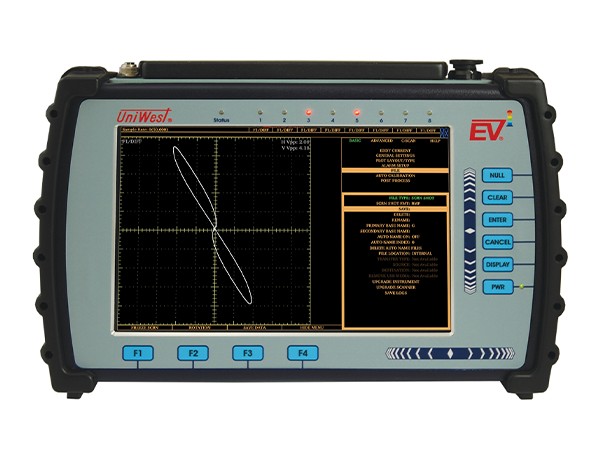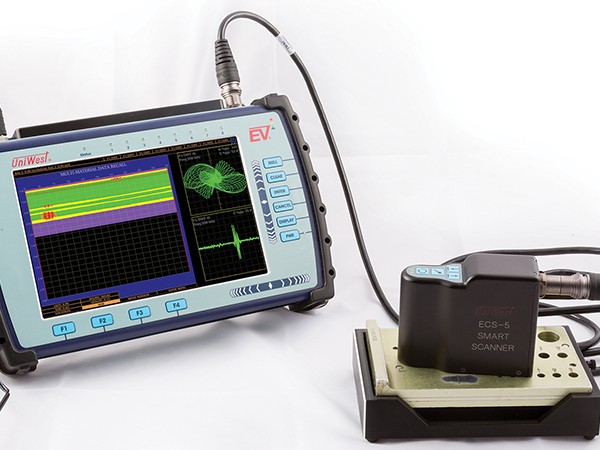EVi Advanced Eddy Current Flaw Detector
EVi is UniWest's most technically advanced and operator-friendly portable Eddy Current Testing (ECT) / Eddy Current Array (ECA) system ever offered.
The EVi works directly with the UniWest family of Standard probes and accessories, as well as eddy current array (ECA) probes up to 128 elements. UniWest’s unmatched selection of standard and advanced display features set a new standard for flexibility of applications, ease of use, interpretation of data and overall operator accuracy.
The key to the EVi’s ground-breaking performance is the display of a visual image of the surface area under inspection alongside the customary and selectable eddy current signal displays (impedance plane, A-scan or strip charts).
The EVi provides a high precision, easily readable display of surface conditions enabling improved interpretation of data while giving more accurate discernment of cracks, pits, gouges and fretting.
By merging innovative surface imaging with UniWest’s renowned, best-in-class signal to noise, the EVi system sets a the standard of precision for eddy current testing in a portable and easy to use package.
Contact us to schedule a demonstration.


- Multi/single frequency
- Multiple display modes
- Easy to use menu driven control
- USB Flash Drive
- Optional External Keyboard

GENERAL
- Dimensions: 13.8″ x 8.75″ x 2.58″ (WxHxD)
- Weight: 7 lb 0 oz without batteries, 9 lb 2 oz with 2 batteries
- Display: 10.1″ WXGA 1280 x 800px
- Operating Temperature:
0 – 45ºC when the battery is charging.
50ºC when operating with a battery
or AC, but not both.
I N P U T S / O U T P U T S
- Power connector: 2.5mm Locking Connector
- Scanner/Probe Connector: 27 Pin Connector
- Probe types: Absolute and differential in either bridge or reflection configuration
- X and Y Analog Outputs: 2 SMA connectors for differential, absolute, or combination
- DB25 connector: 8 configurable encoder, sync or other inputs, 8 configurable alarm, multiplexer, or other outputs, 2 dedicated alarm outputs – TTL and open collector
- Alarm outputs: TTL & Open Collector (multi I/O), Audio or Headphone (USB to 3.5mm adaptor)
- Video output: USB will support external monitors (VGA, DisplayPort, or HDMI with adaptors)
- Ethernet: Remotely control the instrument and retrieve data in real time
- USB port A: Interface to storage devices, keyboard
- USB OTG: Interface to OTG storage devices
- Exportable Files: Report files, data files, settings files
POWER
- Power adaptor requirements: 100-240VAC, 1.4A max
- Power connector: 10VDC-24VDC
- Available batteries: 1 or 2 Lithium DR202i or compatible
- Battery operating time: 5 hours minimum with most scanners, 4 hour recharge rate
- Battery protection: SMBus V1.1 safety features. Monitor battery thermistors, disconnects, and circuit protection. Batteries are hot swappable.
- Battery Charging: Instrument will charge batteries using external power
MEASUREMENTS
- Frequency Range: 120 Hz to 15 MHz
- Gain: 0 dB to 114 dB in 0.1 dB steps
- Rotation: 0 to 359.9º in 0.1º steps
- Sweep: 0.001 sec. to 10 sec. per division
- Low Pass Filter: 0 to 10 kHz
- High Pass Filter: 0 to 10 kHz
- Probe Drive: 2 Vp-p, 4 Vp-p, 7 Vp-p
(Also variable: 0 to 7Vp-p in 1% steps) - Probe Coupling: Monitors the probe to part coupling of a differential probe
- Keyboard: A standard USB keyboard can be connected.
Front Panel Mechanical Buttons
- NULL – nulls instrument
- CLEAR – clears data buffer and error messages
- CANCEL – cancels current operation in menus or closes secondary menus
- DISPLAY – changes where on screen various items are found depending on mode and turns instrument off and on
- ENTER – used to accept changes
- POWER – Turn instrument ON/OFF
- VERTICAL SLIDER – used to change values in menu, navigate screen
- HORIZONTAL SLIDER – navigate screen
- FUNCTION – 4 user programmable keys labeled F1 through F4
(SURFACE AND BOLT HOLE)
- Scanner Recognition: Scanner is recognized once connected and key operating parameters such as motor voltage and encoder resolution are setup in the instrument.
- Surface Scanner Imaging: Colors depict shape, size, and depth of discontinuities
- Bolt Hole Scanner Imaging: Aluminum, Titanium, and Steel layers are identified by color (Green, Brown, Blue)
- Interfaces are identified by color (Yellow)
- Lift-off conditions are identified by color (Purple)
- Flaws are identified by color (Red)
- Data Storage: Up to 300 data files can be saved on the instrument and reviewed later for verification of defects or used for reports
Scanners designed exclusively for use with the EVi
The ECS-5 is UniWest’s EVi-compatible, hand-held bolt hole scanner. Ideal for rotary and linear scan-motion indexing. The ECS-5 supports both absolute and differential coil types in both reflection and bridge configurations. Variable rotation from 250 to 3800 RPM is adjustable in 10 RPM steps at constant torque throughout any speed range.
Ergonomically designed for comfortable handling and rapid inspection of small and hard to reach areas. The portable ECS-3S scanner provides a constant, high-speed scan of the surface. Capable of covering areas as small as ¾ inch, the ECS-3S’s contour-following sensor assembly allows inspection of variable surface gradients. The ECS-3S improves flaw discernment for previously inaccessible remote and obscure surface areas.
Reach Out To Us
Ready for more information or an on-site demonstration?
Click the button below to get started!

